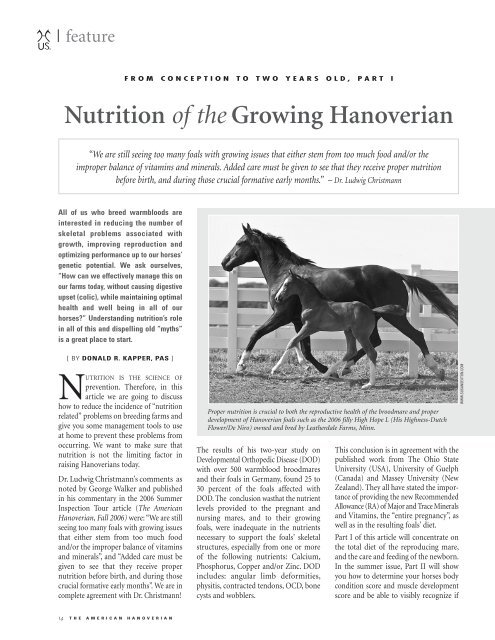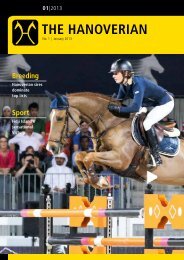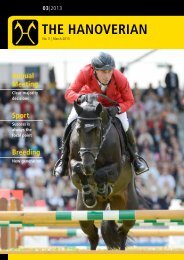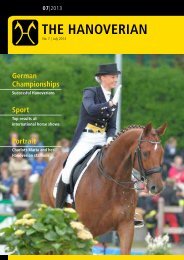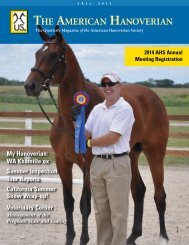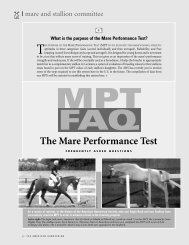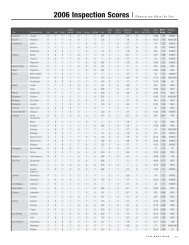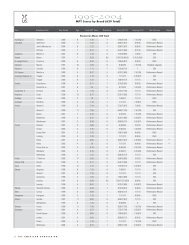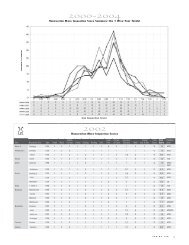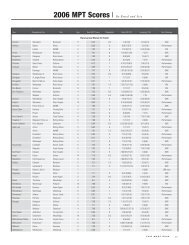Nutrition of the Growing Hanoverian - the American Hanoverian ...
Nutrition of the Growing Hanoverian - the American Hanoverian ...
Nutrition of the Growing Hanoverian - the American Hanoverian ...
Create successful ePaper yourself
Turn your PDF publications into a flip-book with our unique Google optimized e-Paper software.
feature<br />
F r o m C o n c e p t i o n t o T w o Y e a r s O l d , P a r t I<br />
<strong>Nutrition</strong> <strong>of</strong> <strong>the</strong> <strong>Growing</strong> <strong>Hanoverian</strong><br />
“We are still seeing too many foals with growing issues that ei<strong>the</strong>r stem from too much food and/or <strong>the</strong><br />
improper balance <strong>of</strong> vitamins and minerals. Added care must be given to see that <strong>the</strong>y receive proper nutrition<br />
before birth, and during those crucial formative early months.” – Dr. Ludwig Christmann<br />
All <strong>of</strong> us who breed warmbloods are<br />
interested in reducing <strong>the</strong> number <strong>of</strong><br />
skeletal problems associated with<br />
growth, improving reproduction and<br />
optimizing performance up to our horses’<br />
genetic potential. We ask ourselves,<br />
“How can we effectively manage this on<br />
our farms today, without causing digestive<br />
upset (colic), while maintaining optimal<br />
health and well being in all <strong>of</strong> our<br />
horses?” Understanding nutrition’s role<br />
in all <strong>of</strong> this and dispelling old “myths”<br />
is a great place to start.<br />
[ BY Donald R. Kapper, PAS ]<br />
<strong>Nutrition</strong> is <strong>the</strong> science <strong>of</strong><br />
prevention. Therefore, in this<br />
article we are going to discuss<br />
how to reduce <strong>the</strong> incidence <strong>of</strong> “nutrition<br />
related” problems on breeding farms and<br />
give you some management tools to use<br />
at home to prevent <strong>the</strong>se problems from<br />
occurring. We want to make sure that<br />
nutrition is not <strong>the</strong> limiting factor in<br />
raising <strong>Hanoverian</strong>s today.<br />
Dr. Ludwig Christmann’s comments as<br />
noted by George Walker and published<br />
in his commentary in <strong>the</strong> 2006 Summer<br />
Inspection Tour article (The <strong>American</strong><br />
<strong>Hanoverian</strong>, Fall 2006) were: “We are still<br />
seeing too many foals with growing issues<br />
that ei<strong>the</strong>r stem from too much food<br />
and/or <strong>the</strong> improper balance <strong>of</strong> vitamins<br />
and minerals”, and “Added care must be<br />
given to see that <strong>the</strong>y receive proper<br />
nutrition before birth, and during those<br />
crucial formative early months”. We are in<br />
complete agreement with Dr. Christmann!<br />
Proper nutrition is crucial to both <strong>the</strong> reproductive health <strong>of</strong> <strong>the</strong> broodmare and proper<br />
development <strong>of</strong> <strong>Hanoverian</strong> foals such as <strong>the</strong> 2006 filly High Hope L (His Highness-Dutch<br />
Flower/De Niro) owned and bred by Lea<strong>the</strong>rdale Farms, Minn.<br />
The results <strong>of</strong> his two-year study on<br />
Developmental Orthopedic Disease (DOD)<br />
with over 500 warmblood broodmares<br />
and <strong>the</strong>ir foals in Germany, found 25 to<br />
30 percent <strong>of</strong> <strong>the</strong> foals affected with<br />
DOD. The conclusion wasthat <strong>the</strong> nutrient<br />
levels provided to <strong>the</strong> pregnant and<br />
nursing mares, and to <strong>the</strong>ir growing<br />
foals, were inadequate in <strong>the</strong> nutrients<br />
necessary to support <strong>the</strong> foals’ skeletal<br />
structures, especially from one or more<br />
<strong>of</strong> <strong>the</strong> following nutrients: Calcium,<br />
Phosphorus, Copper and/or Zinc. DOD<br />
includes: angular limb deformities,<br />
physitis, contracted tendons, OCD, bone<br />
cysts and wobblers.<br />
This conclusion is in agreement with <strong>the</strong><br />
published work from The Ohio State<br />
University (USA), University <strong>of</strong> Guelph<br />
(Canada) and Massey University (New<br />
Zealand). They all have stated <strong>the</strong> importance<br />
<strong>of</strong> providing <strong>the</strong> new Recommended<br />
Allowance (RA) <strong>of</strong> Major and Trace Minerals<br />
and Vitamins, <strong>the</strong> “entire pregnancy”, as<br />
well as in <strong>the</strong> resulting foals’ diet.<br />
Part I <strong>of</strong> this article will concentrate on<br />
<strong>the</strong> total diet <strong>of</strong> <strong>the</strong> reproducing mare,<br />
and <strong>the</strong> care and feeding <strong>of</strong> <strong>the</strong> newborn.<br />
In <strong>the</strong> summer issue, Part II will show<br />
you how to determine your horses body<br />
condition score and muscle development<br />
score and be able to visibly recognize if<br />
www.Susansexton.com<br />
14 T h e A m e r i c a n H a n o v e r i a n
<strong>the</strong>ir caloric and/or amino acid needs are<br />
being met. It will conclude with <strong>the</strong> newest<br />
information on oils recommended as calorie<br />
sources and <strong>the</strong> important differences in<br />
<strong>the</strong>ir Omega 6 and Omega 3 levels.<br />
The mainstay <strong>of</strong> all horses’ diets is <strong>the</strong> forage<br />
<strong>the</strong>y consume. Understanding how <strong>the</strong> equine<br />
digestive tract functions optimally and how<br />
forage quality and quantity will help maintain<br />
<strong>the</strong> health <strong>of</strong> your horse, reduce <strong>the</strong><br />
incidence <strong>of</strong> colic and keep your horses<br />
growing, reproducing or performing up to<br />
<strong>the</strong>ir genetic potential is what every horse<br />
owner should know. With this knowledge<br />
we can assist you in selecting: 1) <strong>the</strong> best<br />
forage in your area, 2) <strong>the</strong> appropriate<br />
grain mixture to complement your forage<br />
and 3) meet all <strong>the</strong> nutrient needs <strong>of</strong> your<br />
horses. Once horse owners understand that<br />
horses do not have a requirement for cereal<br />
grains, i.e. oats, barley, corn, rice, wheat, etc.,<br />
but <strong>the</strong>y do have an absolute requirement<br />
for forage, it is much easier to grasp how to<br />
successfully manage and feed <strong>the</strong>ir horses.<br />
The only reason to feed a grain mixture or<br />
supplement to horses is to make up <strong>the</strong><br />
difference between what nutrients are in<br />
your forage and what your horses need to<br />
meet <strong>the</strong>ir daily nutrient needs.<br />
Horse Feeds<br />
Horsemen add cereal grains, or grain<br />
mixtures with added vegetable oils, to<br />
increase <strong>the</strong> calories in <strong>the</strong>ir horses’ diet to<br />
increase weight or to maintain <strong>the</strong>ir desired<br />
body condition. It is <strong>the</strong> responsibility <strong>of</strong><br />
<strong>the</strong> feed manufacturer to explain: 1) which<br />
physiological status (growing, reproducing<br />
or performing) <strong>the</strong>ir feed mixture is<br />
formulated to be fed to, 2) what type <strong>of</strong><br />
forage <strong>the</strong>ir grain mixture is formulated to<br />
complement and 3) provide this information<br />
on <strong>the</strong> tag to allow owners or managers to<br />
determine what <strong>the</strong> minimum amount <strong>of</strong><br />
this grain mixture is to be fed per day to<br />
meet all <strong>of</strong> <strong>the</strong> horses’ nutritional needs.<br />
These requirements will vary with a horse’s<br />
size, age, growth rate, reproductive status<br />
and performance level. It is <strong>the</strong>n <strong>the</strong><br />
responsibility <strong>of</strong> <strong>the</strong> owner or manager to<br />
read <strong>the</strong> information on <strong>the</strong> feed tag or bag<br />
and follow those directions. Today, many<br />
horse owners do not realize that if fewer<br />
pounds are fed per day than <strong>the</strong> manufacturer<br />
recommends as “minimum” on <strong>the</strong>ir<br />
feeding directions, <strong>the</strong> horse is being fed a<br />
deficient diet in certain nutrients.<br />
Table 1: Relative Feed Value (RFV) <strong>of</strong> Grass, Mixed and Legume Forages<br />
Hay Quality Standards For: Grass, Grass/Legume Mixed and Legume Forages:<br />
FORAGES – Fresh and Dried<br />
Determining Quality<br />
Forages, by definition, are <strong>the</strong> aerial parts <strong>of</strong><br />
<strong>the</strong> plant commonly fed to livestock. Their<br />
history, as pasture, pre-dates that <strong>of</strong> man.<br />
Forages supply various levels <strong>of</strong> nutrients<br />
depending on <strong>the</strong>ir type (species) and<br />
maturity at harvest. Today <strong>the</strong>y are consumed:<br />
fresh, as pasture; dried, as baled or cubed<br />
hay; or preserved in silos or plastic bags, as<br />
haylage. Horses have limited ability to utilize<br />
poor quality forages, so it is very important<br />
that owners and trainers understand how<br />
to determine quality as well as <strong>the</strong> different<br />
types <strong>of</strong> forages. Since maturity <strong>of</strong> <strong>the</strong> plant<br />
affects <strong>the</strong> digestibility <strong>of</strong> <strong>the</strong> fiber and <strong>the</strong><br />
availability <strong>of</strong> its nutrients, it is vital that<br />
immature forages be fed to horses that need<br />
<strong>the</strong> highest amount <strong>of</strong> nutrients per day.<br />
This would include: sucklings, weanlings<br />
and yearlings, nursing mares and horses in<br />
moderate to intense training. The first visual<br />
appraisal <strong>of</strong> all types <strong>of</strong> forage includes: 1)<br />
<strong>the</strong> length <strong>of</strong> <strong>the</strong> seed head in grasses (boot<br />
stage) and 2) <strong>the</strong> percent <strong>of</strong> blossoms in<br />
bloom in legumes (bud stage). Ideally,<br />
grasses should have seed heads less than<br />
one inch long and legumes should have less<br />
than ten percent <strong>of</strong> <strong>the</strong> buds in blossom. As<br />
all plants prepare to blossom, <strong>the</strong> Acid<br />
Detergent Fiber (ADF), which measures<br />
Crude Fiber (Cellulose plus Insoluble<br />
Lignin) and Soluble Lignin, and <strong>the</strong> Neutral<br />
Detergent Fiber (NDF), which measures<br />
<strong>the</strong> ADF plus Hemi-Cellulose, increases so<br />
<strong>the</strong> stem has enough strength to hold up<br />
<strong>the</strong> seed heads or blossoms. Unfortunately,<br />
as <strong>the</strong> fiber portion increases, all o<strong>the</strong>r<br />
nutrients decrease and become less digestible<br />
and available to <strong>the</strong> horse.<br />
Analysisb (dry matter basis)<br />
Quality Standard a ADF % NDF % DMI, c % <strong>of</strong> B. Wt. RFV d<br />
Prime (Prime) 151<br />
1 (Premium) 31-35 41-46 3.0-2.6 150-125<br />
2 (Good) 36-40 47-53 2.5-2.3 124-103<br />
3 (Fair) 41-42 54-60 2.2-2.0 102-87<br />
4 (Poor) 43-45 61-65 1.9-1.8 86-75<br />
5 (Reject) >46 >66
Table 2: Protein and Calorie Levels in Forages, Based on Type and Maturity*.<br />
Quality Standard<br />
%<br />
Protein<br />
Grass Grass/Legume Mixed (50/50) Legume<br />
%<br />
Lysine f<br />
MCal.<br />
DE/lb. e<br />
%<br />
Protein<br />
%<br />
Lysine f<br />
MCal.<br />
DE/lb. e<br />
%<br />
Protein<br />
%<br />
Lysine f<br />
MCal.<br />
DE/lb. e<br />
Prime (Prime) >11 >.38 >1.05 >16 >.68 >1.10 >21 >1.07 >1.17<br />
1 (Premium) 8-10 .31 .95 13-15 .60 1.03 18-20 .97 1.10<br />
2 (Good) 7-8 .26 .86 11-13 .51 .93 16-18 .87 1.00<br />
3 (Fair) 5-7 .21 .80 9-11 .43 .86 14-16 .77 .94<br />
4 (Poor) 4-5 .16 .77 7-9 .34 .82 12-14 .66 .89<br />
5 (Reject)
660 lbs to 1,540 lbs, and 3) heavy horses –<br />
from 1,540 lbs to 2,200 lbs <strong>of</strong> potential<br />
mature body weights. The growth curves,<br />
which indicate “normal” growth rates from<br />
birth to thirty-six (36) months <strong>of</strong> age, are<br />
taken from <strong>the</strong> tables in Horse NRC. Proper<br />
use <strong>of</strong> <strong>the</strong>se charts will assure us that<br />
nutrition is not <strong>the</strong> limiting factor for<br />
horses. Feeding <strong>the</strong> correct amount <strong>of</strong> a<br />
selected grain mixture or supplement, will<br />
allow all foals to reach <strong>the</strong>ir inherent genetic<br />
potential and reduce <strong>the</strong> nutrition related<br />
growth problems seen in horses today.<br />
The number inside each rectangle on <strong>the</strong><br />
Growth Chart reflects <strong>the</strong> amount <strong>of</strong> minerals<br />
and vitamins necessary to maintain <strong>the</strong><br />
Recommended Allowance (RA) for that<br />
particular size and growth rate for foals. We<br />
call this number a Progressive “Unit”. It<br />
does not reflect <strong>the</strong> necessary calories to<br />
maintain desired body condition, because<br />
<strong>of</strong> <strong>the</strong> calorie variability found in today’s<br />
forages being consumed and <strong>the</strong> owner/<br />
trainer/manager will feed varying amounts<br />
<strong>of</strong> a grain mixture to meet <strong>the</strong>ir desired<br />
body condition in <strong>the</strong>ir horses. However,<br />
what everyone needs to know is, “What<br />
are <strong>the</strong> minimum pounds to achieve <strong>the</strong><br />
Recommended Allowance (RA) and <strong>the</strong><br />
maximum pounds to not exceed <strong>the</strong> Safe<br />
Upper Limit (SUL) <strong>of</strong> <strong>the</strong>ir selected grain<br />
mixture <strong>the</strong>y are feeding”. The Growth<br />
Monitoring Charts will provide this information<br />
for you.<br />
We do not recommend trying to speed up<br />
or to slow down growth rate. Just let <strong>the</strong><br />
young horses grow up to <strong>the</strong>ir genetic<br />
potential, while providing <strong>the</strong> nutrients<br />
needed to match <strong>the</strong>ir current growth rate.<br />
The Progressive “Unit” is made up <strong>of</strong> protein<br />
(amino acids), fats (fatty acids), major<br />
minerals, trace minerals and vitamins<br />
necessary to complement <strong>the</strong> analysis <strong>of</strong><br />
different forages. The pelleted supplements<br />
in Table 5 are concentrated sources <strong>of</strong><br />
nutrients and one “Unit” is equal to one<br />
“pound” <strong>of</strong> <strong>the</strong> appropriate supplement.<br />
How many “Units” to feed per day will<br />
depend on your horses’ age, size, current<br />
growth rate, reproductive status and/or<br />
performance level. Which pelleted supplement<br />
to feed will depend on <strong>the</strong> type <strong>of</strong> forage<br />
you feed your horse (grass or legume).<br />
Pregnancy<br />
The implementation <strong>of</strong> <strong>the</strong> published<br />
research from <strong>the</strong> Cornell and Illinois<br />
Table 5: The Analysis <strong>of</strong> Two Different Pelleted Supplements Available to<br />
Complement Different Forage Types<br />
Nutrients<br />
Feed with Grass or Mixed Forage<br />
“ProAdvantage Grass”<br />
Feed with Legume Forage<br />
“ProAdvantage Alfalfa”<br />
Dry Matter, % 90.0 90.0<br />
Crude Protein, % 30.0 14.0<br />
Crude Fat, % 5.5 5.5<br />
Crude Fiber, % 5.0 15.0<br />
Calcium, % 3.0 1.5<br />
Phosphorus, % 1.5 1.5<br />
Potassium, % 1.5 .8<br />
Magnesium, % .4 .4<br />
Manganese, ppm* 260.0 260.0<br />
Iron, ppm* 240.0 240.0<br />
Copper, ppm* 200.0 200.0<br />
Zinc, ppm* 500.0 500.0<br />
Iodine, ppm* 3.0 3.0<br />
Selenium, ppm( 1.5 1.5<br />
Vitamin A, IU/lb 22,000 22,000<br />
Vitamin D, IU/lb 2,200 2,200<br />
Vitamin E, IU/lb 350 350<br />
* ppm is <strong>the</strong> same as mg/kg.<br />
Table 6: Growth Monitoring Chart<br />
Veterinary Departments stating <strong>the</strong> nutrients<br />
received in <strong>the</strong> middle trimester <strong>of</strong> pregnancy<br />
is just as important as <strong>the</strong> last trimester has<br />
helped many breeding farms improve <strong>the</strong><br />
health <strong>of</strong> <strong>the</strong> mares and reduce early developmental<br />
problems in <strong>the</strong>ir foals. This change<br />
in feeding practice has allowed <strong>the</strong> mare to<br />
replenish and build her body reserves to<br />
assure she can supply <strong>the</strong> foal during <strong>the</strong>ir<br />
most rapid growth phase during <strong>the</strong> last 4<br />
S P R I N G 2 0 0 7 17
trimester <strong>of</strong> pregnancy. Owners and veterinarians<br />
have stated: 1) improved reproductive<br />
health and conception rates, 2) reduced<br />
incidence <strong>of</strong> nutrition related fetal developmental<br />
problems and 3) <strong>the</strong> ease <strong>of</strong><br />
management <strong>of</strong> feeding all <strong>the</strong>ir pregnant<br />
mares <strong>the</strong> same <strong>the</strong> entire pregnancy.<br />
The Lactating Mare<br />
During <strong>the</strong> first three months <strong>of</strong> lactation,<br />
most mares will produce between 3.0 and<br />
3.5 percent <strong>of</strong> <strong>the</strong>ir body weight in fluid<br />
milk each day. Peak lactation can occur<br />
between four to ten weeks postpartum, with<br />
<strong>the</strong> average being five to six weeks. As<br />
lactation continues, milk yield will decline<br />
to two percent <strong>of</strong> her body weight between<br />
<strong>the</strong> fourth and fifth month. The amount <strong>of</strong><br />
milk a mare produces will depend on her:<br />
1) genetic potential, but remember maiden<br />
mares will produce less than mares with<br />
previous lactations,<br />
2) nutrient supply (especially daily<br />
consumption <strong>of</strong> protein, calories<br />
and water); and<br />
3) individual foal intake.<br />
The nutrient composition <strong>of</strong> milk also<br />
changes during lactation. Mare’s milk will<br />
become more nutrient dilute as lactation<br />
progresses. Protein, fat, major and trace<br />
minerals and vitamin content decrease and<br />
lactose increases. Water is <strong>the</strong> major constituent<br />
<strong>of</strong> mare’s milk, being approximately<br />
90 percent, and <strong>the</strong> mares appetite, or <strong>the</strong><br />
total daily consumption <strong>of</strong> forage plus grain<br />
mixture, will increase according to her<br />
individual milk production. Table 7 shows<br />
how much total feed will be consumed per<br />
day by pregnant and nursing mares, as a<br />
percent <strong>of</strong> <strong>the</strong>ir individual body weight.<br />
Managers must watch <strong>the</strong> nursing mare’s<br />
nutrient input – output relationship. If <strong>the</strong><br />
mare is providing more nutrients into her<br />
milk than she is taking in, she will draw<br />
from her body reserves until her nutritional<br />
reserves are depleted. For example, if calories<br />
are in short supply, her fat stores will be<br />
used up and she will lose body weight. If<br />
protein is in short supply, her muscle mass<br />
will be sacrificed, because proteins are<br />
stored in <strong>the</strong> muscle. The first place to visually<br />
see muscle loss is <strong>the</strong>ir top-line, i.e.,<br />
wi<strong>the</strong>rs, back and loin areas. This negative<br />
balance, major and trace minerals included,<br />
will deplete her body reserves, <strong>the</strong>n lower<br />
those nutrients in her milk, and have a<br />
negative effect on her conception rate or<br />
Table 7: Total Feed Consumed per Day by Pregnant and Nursing Mares<br />
Reproductive Status<br />
nutrients available for her next foal’s fetal<br />
development. This, <strong>of</strong> course, is in addition<br />
to your mare’s decline in health.<br />
The mare’s nutrients in greatest demand<br />
are water and calories, followed by protein,<br />
major minerals, trace minerals and vitamins.<br />
Mare’s milk is approximately 90 percent<br />
water. A 1,300 lb mare, producing 5 ½ gallons<br />
<strong>of</strong> milk per day, would have to increase her<br />
water intake nearly two fold to replenish<br />
this loss.<br />
Early in lactation, mare’s milk contains<br />
approximately 560 kcal/kg <strong>of</strong> fluid milk.<br />
Assuming mares convert 60 percent <strong>of</strong> feed<br />
Digestible Energy (DE) into milk gross<br />
energy, an extra 792 kcal <strong>of</strong> DE must<br />
be consumed for every kilogram <strong>of</strong> milk<br />
produced. This would be an increase <strong>of</strong> 72<br />
percent above maintenance, which is why<br />
lactating mares need to consume 2.5 to 3.5<br />
percent <strong>of</strong> <strong>the</strong>ir body weight in total feed<br />
per day, or <strong>the</strong>y will lose weight.<br />
Amount <strong>of</strong> Hay plus Grain Mixture to Feed/Day as<br />
a % <strong>of</strong> Body Weight<br />
Pregnant 1.5 to 2.0 %<br />
Nursing, birth to 3 months 2.5 to 3.5 %<br />
Nursing, 4 to 6 months 2.0 to 3.0 %<br />
Table 8: Compares <strong>the</strong> Mare’s Recommended Allowance (RA) while: Open, Pregnant and<br />
Lactating, in her Total Diet on a Dry Matter Basis. (This is <strong>the</strong> average, or total nutrients<br />
found, in everything she eats/day, including: forage, grain mixture, supplements, etc.)<br />
Nutrient Open Pregnant<br />
Protein needs have been estimated to be<br />
almost double from those <strong>of</strong> maintenance.<br />
Calcium and phosphorus losses during<br />
lactation <strong>of</strong> <strong>the</strong> mare’s body reserves can be<br />
significant if adequate supplementation <strong>of</strong><br />
<strong>the</strong>se essential minerals is not provided.<br />
Brittle bones are unfortunately <strong>the</strong> end<br />
result.<br />
The trace mineral and vitamin content <strong>of</strong><br />
mare’s milk is now available from several<br />
published studies. All trace minerals are<br />
low in mare’s milk and is believed to be one<br />
<strong>of</strong> <strong>the</strong> genetic components <strong>of</strong> DOD. It is<br />
now possible to monitor a mare’s milk, on a<br />
monthly basis, by analyzing it and comparing<br />
it to Table 9.<br />
Newborn Foals<br />
Lactation<br />
(1-3 Months)<br />
Lactation<br />
(4-6 Months)<br />
Dry Matter intake, % body wt* 1.5-2.0 1.5-2.0 2.5-3.5 2.0-3.0<br />
Crude Protein, % 8.50 11.50 15.00 13.00<br />
Calcium, % .30 .53 .70 .50<br />
Phosphorus, % .21 .35 .43 .28<br />
Potassium, % .40 .50 .80 .60<br />
Magnesium, % .10 .12 .15 .12<br />
Sodium, %** .14 .14 .20 .16<br />
Copper, ppm 15 25 25 25<br />
Iron, ppm 40 80 80 80<br />
Manganese, ppm 40 60 60 60<br />
Zinc, ppm 40 70 70 70<br />
Cobalt, ppm .10 .20 .30 .20<br />
Iodine, ppm .15 .25 .35 .25<br />
Selenium, ppm .15 .20 .30 .20<br />
Vitamin A, IU/lb 900 900 900 900<br />
Vitamin E, IU/lb 23 36 36 36<br />
Thiamine, mg/lb 1.3 1.3 1.3 1.3<br />
Rib<strong>of</strong>lavin, mg/lb 0.9 0.9 0.9 0.9<br />
*Feed intake is determined by: Body capacity, RFV <strong>of</strong> forage, physiological status, activity level and environment.<br />
**Under average conditions .35% to .50% Salt (NaCl) is recommended in <strong>the</strong> total diet.<br />
Needed Digestible Energy, Mcal/Day, is determined by: Body size, metabolic rate, reproductive status, dry matter<br />
consumption and Body Condition Score.<br />
At birth, normal size foals should weigh<br />
between ten and 12 percent <strong>of</strong> <strong>the</strong> mare’s<br />
body weight. For example, foals from a<br />
18 T h e A m e r i c a n H a n o v e r i a n
Table 9: Mare’s Milk Nutrient Composition by Week, on a Dry Matter (top) and As Fed Basis (bottom)<br />
Dry Matter Basis<br />
% Total<br />
Solids<br />
Energykcal/<br />
100g<br />
%<br />
Protein<br />
1,300 lb. mare should weigh between 130<br />
and 150 lbs at birth. Maiden mare foals<br />
should weigh between eight and ten percent<br />
<strong>of</strong> <strong>the</strong>ir body weight.<br />
Within <strong>the</strong> first hour after birth, <strong>the</strong> foal<br />
should begin to receive colostrum. A 100 lb<br />
foal should receive 250 ml (about one cup)<br />
<strong>of</strong> colostrum each hour for <strong>the</strong> first six hours<br />
after birth. That means that every breeding<br />
farm should have at least 1500 ml <strong>of</strong> frozen<br />
colostrum in <strong>the</strong>ir freezer, just in case.<br />
Bacterial exposure to <strong>the</strong> “open gut” <strong>of</strong> <strong>the</strong><br />
newborn foal is considered <strong>the</strong> mechanism<br />
for septicemia, <strong>the</strong> leading cause <strong>of</strong> death<br />
in neonatal foals. The “open gut” will allow<br />
<strong>the</strong> foal to absorb immunoglobulins, such as<br />
IgG, IgM, IgE and IgA, from <strong>the</strong> colostrum,<br />
but it also allows <strong>the</strong> absorption <strong>of</strong> harmful<br />
pathogens from <strong>the</strong> environment. Dr. John<br />
Madigan at <strong>the</strong> University <strong>of</strong> California-<br />
Davis, stated that early (rapid) gut closure<br />
may be equivalent to or more important<br />
than simply serum IgG in <strong>the</strong> preventing<br />
neonatal bacterial infection.<br />
The average foal will drink seven to ten<br />
times per hour for <strong>the</strong> first 30 days <strong>of</strong> age.<br />
(Remember this if you have an orphan or<br />
rejected foal) This readily available food<br />
source is necessary to support <strong>the</strong>rmoregulation<br />
and growth.<br />
The Suckling’s Digestive System<br />
%<br />
Fat<br />
During every foal’s first four months <strong>the</strong>re<br />
are rapid growth and digestive changes. To<br />
achieve each foal’s genetic potential, we<br />
must provide a feed to complement <strong>the</strong>ir<br />
%<br />
Lactose<br />
%<br />
Ash (b)<br />
%<br />
Calcium<br />
%<br />
Phosphorus<br />
%<br />
Magnesium<br />
%<br />
Potassium<br />
%<br />
Na<br />
mg/kg<br />
Copper<br />
mg/<br />
kgZinc<br />
mg/kgIron c<br />
Birth ------ 536 75.79 2.78 18.25 2.86 0.34 .16 .19 .45 .21 3.93 25.40 5.20<br />
12 hrs. ------ 557 33.04 20.87 41.74 4.35 0.68 .35 .12 .84 .32 7.22 24.40 8.26<br />
24 hrs. ------ 544 28.95 21.93 45.61 4.65 0.85 .39 .10 .74 .30 6.40 31.60 9.21<br />
1 - 4 wk ------ 542 25.23 16.82 57.94 4.91 1.12 .68 .08 .65 .21 4.21 23.36 7.99<br />
5 - 8 wk ------ 505 20.95 16.19 60.95 3.81 0.95 .57 .06 .48 .18 2.48 19.05 6.29<br />
9 - 12 wk ------ 500 18.00 14.00 65.00 3.00 0.80 .50 .05 .40 .15 2.00 18.00 4.90<br />
As Fed Basis<br />
Birth b 25.2 135 19.1 0.7 4.6 .72 .085 .039 .0473 .11 .052 .99 6.4 1.31<br />
12 hrs b 11.5 64 3.8 2.4 4.8 .50 .078 .040 .0138 .10 .036 .83 2.8 .095<br />
24 hrs b 11.4 62 3.3 2.5 5.2 .53 .097 .044 .0110 .08 .034 .73 3.6 1.05<br />
1-4 wk a 10.7 58 2.7 1.8 6.2 .53 .120 .073 .0090 .07 .023 .45 2.5 0.86<br />
5-8 wk a 10.5 53 2.2 1.7 6.4 .40 .100 .060 .0060 .05 .019 .26 2.0 0.66<br />
9-21 wk a 10.0 50 1.8 1.4 6.5 .30 .080 .050 .0045 .04 .015 .20 1.8 0.49<br />
a NRC 1989, Nutrient Requirements <strong>of</strong> Horses, Summary pg. 95<br />
b Ullrey, DE., Stru<strong>the</strong>rs, R.D., Hendricks, D.G., and Brent, B.E., 1966 Composition <strong>of</strong> Mare’s Milk, Jan. Sci. 25:217<br />
c Ullrey, D.E., Ely, W.T., and Covert, R.L., 1974. Iron, Zinc and Copper in Mare’s Milk, J. Anim. Sci. 38:1276<br />
igestive Enzyme Activity <strong>of</strong> <strong>the</strong> Young Gro<br />
Figure 1: Digestive Enzyme Activity <strong>of</strong> <strong>the</strong> Young <strong>Growing</strong> Horse<br />
Kapper, D.R., “Applied <strong>Nutrition</strong>”, editor: Reed, SM, Equine Internal Medicine, 2nd Edition,<br />
Saunders & Co., St. Louis, MO 2004, pp 1565.<br />
type <strong>of</strong> digestive system, in a form <strong>the</strong>y can<br />
absorb, and fortify it to meet all <strong>of</strong> <strong>the</strong>ir<br />
nutrient needs. This “Foal’s First” feed should<br />
be provided free choice in an area that <strong>the</strong><br />
mares will loiter, but cannot reach or get into.<br />
A common management practice in <strong>the</strong><br />
past has been to allow nursing foals to eat<br />
with <strong>the</strong>ir dams. Unfortunately, <strong>the</strong> foal<br />
under two months <strong>of</strong> age has little ability to<br />
digest <strong>the</strong> starch in cereal grains. During<br />
<strong>the</strong> foals first three months <strong>of</strong> life, <strong>the</strong>ir<br />
digestive enzymes are more efficient at<br />
breaking down and absorbing milk (Fig. 1).<br />
As <strong>the</strong> foal ages, <strong>the</strong> digestive enzymes also<br />
change. When <strong>the</strong> foal is between three and<br />
four months <strong>of</strong> age, amylase surpasses lactase<br />
allowing <strong>the</strong>m begin to digest <strong>the</strong> starches<br />
in cereal grains. Therefore, all nursing foals,<br />
up to four months <strong>of</strong> age, should have<br />
available a milk-based foal feed to optimize<br />
absorption. To meet <strong>the</strong>ir nutrient needs,<br />
this free choice milk-based pellet should be<br />
formulated to compliment mare’s milk, not<br />
forage. This “first feed” provided for foals<br />
will result in optimal nutrient absorption,<br />
while reducing <strong>the</strong> chance <strong>of</strong> digestive upset,<br />
i.e. colic and diarrhea. How much <strong>of</strong> this feed<br />
is consumed per day will be directly related<br />
to: how much milk <strong>the</strong> mare is producing<br />
per day, <strong>the</strong> age <strong>of</strong> <strong>the</strong> foal and <strong>the</strong> size <strong>of</strong><br />
<strong>the</strong> foal in relation to <strong>the</strong> mare.<br />
Suckling Foals Showing Signs <strong>of</strong> DOD<br />
If <strong>the</strong> foals’ legs are normal at birth and<br />
acquire leg deviations with age, but all <strong>the</strong>y<br />
are consuming is <strong>the</strong> mare’s milk, it is only<br />
logical to analyze her milk and compare it<br />
to <strong>the</strong> expected mineral density average<br />
listed above. If a mare has had foals in <strong>the</strong><br />
past with DOD, we would consider her a<br />
“suspect mare”. We recommend analyzing<br />
her milk on day seven after foaling, <strong>the</strong>n 4<br />
S P R I N G 2 0 0 7 19
Table 10: Compares <strong>the</strong> <strong>Growing</strong> Horse’s Recommended Allowance (RA) on a Total Diet, Dry Matter Basis<br />
(This is <strong>the</strong> average, or total nutrients found, in everything <strong>the</strong>y eat/day, including: forage, grain mixture, supplements, etc).<br />
Nutrient<br />
Weanling<br />
(4-6 months)<br />
Weanling<br />
(6-12 months)<br />
Yearling<br />
(12-18 months)<br />
Long Yearling<br />
(18-24 months) 24 to 36 months <strong>of</strong> age<br />
*Dry Matter Intake, % body wt 2.25-2.75 2.75-3.25 2.25-2.75 2.0-2.5 1.75-2.25<br />
Crude Protein, % 18.00 16.00 14.00 12.00 11.00<br />
Calcium, % .90 .80 .70 .60 .53<br />
Phosphorus, % .48 .43 .32 .25 .22<br />
Potassium, % .90 .80 .70 .60 .53<br />
Magnesium, % .20 .19 .18 .15 .12<br />
Sodium, % .10 .12 .14 .14 .14<br />
Copper, ppm 35 30 25 22 20<br />
Iron, ppm 100 90 80 70 60<br />
Manganese, ppm 65 60 55 50 45<br />
Zinc, ppm 100 90 80 70 60<br />
Cobalt, ppm .30 .30 .25 .25 .20<br />
Iodine, ppm .35 .35 .30 .30 .25<br />
Selenium, ppm .30 .30 .25 .25 .20<br />
Vitamin A, IU/lb 1,365 1,365 1,135 1,135 910<br />
Vitamin E, IU/lb 43 43 41 39 26<br />
Thiamine, mg/lb 1.8 1.8 1.6 1.6 1.3<br />
Rib<strong>of</strong>lavin, mg/lb 1.3 1.3 1.1 1.1 .9<br />
*Feed Intake is determined by: Body capacity, physiological status, activity level, RFV <strong>of</strong> forage and environment.<br />
Needed Digestible Energy, Mcal/day, is determined by: Body size, metabolic rate, growth rate, dry matter consumption and Body Condition Score.<br />
again in week four, eight and 12, and compare<br />
her milk mineral density to <strong>the</strong> appropriate<br />
line on Table 9. There is a product on <strong>the</strong><br />
market today, Rejuvenaide, which is formulated<br />
to complement mares’ milk and is<br />
to be given orally to <strong>the</strong> foal, as a drench,<br />
once a day. This is <strong>the</strong> product that Dr.<br />
Christmann asked me to be sure every<br />
breeder knew was available to help our<br />
foals. Rejuvenaide is a trace mineral and<br />
vitamin supplement that will enable <strong>the</strong><br />
broodmare manager to keep <strong>the</strong> nutrient<br />
deficient foal on <strong>the</strong> mare ra<strong>the</strong>r than having<br />
to wean early. However, if <strong>the</strong> foal is over four<br />
months <strong>of</strong> age when acquired contractures<br />
begin to occur, it is easier and more<br />
economical to wean and put <strong>the</strong> foal on<br />
a balanced weanling formula to assure<br />
adequate consumption <strong>of</strong> all nutrients. The<br />
manager must <strong>the</strong>n make sure <strong>the</strong> correct<br />
numbers <strong>of</strong> Progressive “Units” are fed per<br />
day to complement <strong>the</strong> foals’ growth rate<br />
(age vs. size).<br />
Several research projects have been published<br />
that prove adequate or above amounts <strong>of</strong><br />
crude protein (amino acids) do not cause<br />
DOD. Dr. Ed Ott, from <strong>the</strong> University <strong>of</strong><br />
Florida, has published that feeding protein<br />
levels below <strong>the</strong> Horse NRC’s recommendations<br />
will cause: decrease in bone density<br />
and compromised tendon and ligament<br />
strength. As long as <strong>the</strong> amount <strong>of</strong> crude<br />
protein was below NRC’s recommendation,<br />
increasing <strong>the</strong> mineral density in <strong>the</strong> diet<br />
had no affect on <strong>the</strong> skeletal and s<strong>of</strong>t tissue<br />
structures <strong>of</strong> young, growing horses. O<strong>the</strong>r<br />
publications state <strong>the</strong> only link between<br />
Rejuvenaide Aid Analysis<br />
(per 5cc drench or 2 cc paste)<br />
Copper<br />
Zinc<br />
Selenium<br />
Ascorbic Acid<br />
Vitamin A<br />
Vitamin D<br />
Vitamin E<br />
3.20 mg<br />
9.40 mg<br />
0.25 mg<br />
100.00 mg<br />
3,500 IU<br />
350 IU<br />
100 IU<br />
adequate protein fed and DOD is when one or<br />
more <strong>of</strong> <strong>the</strong> minerals (calcium, phosphorus,<br />
copper and zinc) were fed below <strong>the</strong><br />
Recommended Allowance (RA). If physitis or<br />
tendon, angular or flexure, deformities occur:<br />
1) check <strong>the</strong> diet <strong>of</strong> <strong>the</strong> pregnant and<br />
nursing mare for nutrient adequacy or<br />
imbalances<br />
2) analyze <strong>the</strong> mares milk for minerals<br />
3) consider feeding appropriate amounts<br />
<strong>of</strong> Rejuvenaide every day to <strong>the</strong> foal, or<br />
weaning <strong>the</strong> foal if over four months old<br />
DO NOT starve <strong>the</strong> mare or foal! If <strong>the</strong>se<br />
problems are caused from a nutritional<br />
deficiency, how can we fix it by creating a<br />
larger deficiency?<br />
Feeding <strong>the</strong> Young, <strong>Growing</strong> Horse<br />
After four months <strong>of</strong> age <strong>the</strong>re is no reason<br />
to feed quantities <strong>of</strong> milk to <strong>the</strong> growing<br />
foal. Provide a weanling diet according to<br />
desired body condition and Recommended<br />
Allowance (see Table 6). Because <strong>the</strong><br />
younger horse’s body capacity is small, <strong>the</strong><br />
percentages <strong>of</strong> all nutrients in a weanling<br />
diet must be higher to assure adequate<br />
amounts <strong>of</strong> minerals and vitamins will be<br />
consumed per day. As <strong>the</strong> body capacity<br />
increases, <strong>the</strong> percentages can be lowered<br />
because <strong>the</strong>y are consuming more pounds<br />
per day (see Table 10).<br />
After six months <strong>of</strong> age <strong>the</strong>ir digestive system<br />
is changing into more <strong>of</strong> a continuous<br />
grazer and we continue to manage <strong>the</strong><br />
weanling to complement <strong>the</strong>ir digestive<br />
system. The larger <strong>the</strong> body capacity, <strong>the</strong><br />
larger <strong>the</strong> fermentation vat and <strong>the</strong>refore,<br />
more forage can be consumed. However,<br />
<strong>the</strong> increased body capacity for forage does<br />
not keep up with <strong>the</strong> increased mineral<br />
requirements for skeletal development. The<br />
larger, faster growing foals are more prone<br />
to skeletal problems due to <strong>the</strong>ir higher<br />
mineral needs to support <strong>the</strong>ir larger structure.<br />
Therefore, using <strong>the</strong> Growth Chart (Table 6)<br />
to determine <strong>the</strong>ir individual Recommended<br />
Allowances (RA) is <strong>the</strong> manager’s best tool<br />
to reduce <strong>the</strong> incidence <strong>of</strong> nutrition related<br />
growth problems.<br />
Because young foals do not grow at <strong>the</strong><br />
same rate and mature to different sizes,<br />
<strong>the</strong>ir daily nutritional needs differ. The<br />
smaller horses will usually mature earlier<br />
and <strong>the</strong> larger horses will take longer. Even<br />
within breeds <strong>the</strong>re are different maturing<br />
rates. The only way to meet <strong>the</strong> growing<br />
horse’s nutrient needs is to monitor <strong>the</strong>ir<br />
growth every month and provide <strong>the</strong> necessary<br />
“Units” <strong>of</strong> amino acids, major and<br />
trace minerals and vitamins according to<br />
<strong>the</strong>ir individual growth rate.<br />
20 T h e A m e r i c a n H a n o v e r i a n
Conclusion <strong>of</strong> Part I<br />
In conclusion, <strong>the</strong>re are two very important<br />
management decisions that need to be<br />
made which are necessary to reduce <strong>the</strong><br />
incidence <strong>of</strong> “nutrition related” development<br />
problems.<br />
Number one - “Fetal Programming”: The<br />
reliance on adequate prenatal nutrition<br />
is extremely important and needs to be<br />
greatly emphasized in preventing nutritional<br />
deficiencies from occurring in <strong>the</strong><br />
suckling. The point at which mare’s milk<br />
and <strong>the</strong> foal’s liver stores can no longer<br />
provide <strong>the</strong> trace mineral needs <strong>of</strong> <strong>the</strong> foal<br />
can be seen in rapidly growing foals,<br />
consuming only mare’s milk, and beginning<br />
to show signs <strong>of</strong> Developmental Orthopedic<br />
Disease (DOD). If this occurs before <strong>the</strong><br />
suckling begins consuming an adequate<br />
amount <strong>of</strong> dry feed, we will look into <strong>the</strong><br />
possibility <strong>of</strong> low mineral density in this<br />
mare’s milk as a cause. The research published<br />
over <strong>the</strong> past several years, clearly<br />
states that trace mineral supplementation<br />
is beneficial in <strong>the</strong> sucklings’ diet when <strong>the</strong><br />
mare has previously produced a foal with,<br />
what is believed to be, nutrition induced<br />
DOD. Comparing <strong>the</strong> suspect mare’s milk<br />
analysis to Table 9, will allow <strong>the</strong> owner/<br />
veterinarian/nutritionist to explain why<br />
and how much Rejuvenaide, a trace mineral<br />
supplement to complement mares milk, is<br />
necessary to administer per day.<br />
Number two - “Feed According to Need”:<br />
Monitor your foals’ growth rates and feed<br />
accordingly. Be sure to provide <strong>the</strong> correct<br />
number <strong>of</strong> “Units” (amino acids, fatty acids,<br />
major and trace minerals and vitamins)<br />
necessary to “support” <strong>the</strong>ir current growth<br />
rate and size <strong>of</strong> <strong>the</strong>ir skeletal structure,<br />
without getting <strong>the</strong>m fat. We do not recommend<br />
trying to slow <strong>the</strong>ir growth rate<br />
down or to speed <strong>the</strong>m up. Breed for <strong>the</strong><br />
size horse you want to produce and feed<br />
<strong>the</strong>m accordingly.<br />
We have had <strong>the</strong> most success in reducing<br />
<strong>the</strong> incidence <strong>of</strong> DOD on farms today<br />
when <strong>the</strong>se two management “tools” are<br />
used toge<strong>the</strong>r. To reduce skeletal anomalies,<br />
all owners and managers must realize that<br />
nutrition, management and genetics are<br />
all “equal”. You have to have <strong>the</strong> best <strong>of</strong><br />
all three if you want to attain “optimal<br />
results”. n<br />
Donald R. Kapper, PAS, is <strong>the</strong> Director <strong>of</strong><br />
<strong>Nutrition</strong> and Technical Services at Progressive<br />
<strong>Nutrition</strong>, LLC and a team member <strong>of</strong> Akey<br />
<strong>Nutrition</strong> Research and Development and<br />
<strong>Nutrition</strong> Horizon Research and Development<br />
at North <strong>American</strong> <strong>Nutrition</strong> Companies, Inc.<br />
He is a graduate <strong>of</strong> The Ohio State University<br />
and a member <strong>of</strong> <strong>the</strong> Equine Science Society,<br />
<strong>the</strong> <strong>American</strong> Registry <strong>of</strong> Pr<strong>of</strong>essional Animal<br />
Scientists (PAS), <strong>the</strong> <strong>American</strong> Farriers Association,<br />
<strong>the</strong> <strong>American</strong> <strong>Hanoverian</strong> Society and <strong>the</strong> ISR/<br />
Oldenburg N.A. Society. In 1983, he assisted in<br />
<strong>the</strong> development <strong>of</strong> <strong>the</strong> first comprehensive<br />
computer program to balance equine diets. He<br />
consults with industry leaders and has lectured<br />
throughout <strong>the</strong> world to horse owners, trainers<br />
and veterinarians. He is <strong>the</strong> exclusive Equine<br />
<strong>Nutrition</strong>ist for <strong>the</strong> 1998, 2002, 2004 and<br />
<strong>the</strong> 2007 Sporthorse Stallion Testing LLC’s<br />
100-Day Stallion Performance Tests. In 2003,<br />
Don assisted in writing <strong>the</strong> text and taught<br />
<strong>the</strong> first Equine Science Certificate Class,<br />
“Introductory Equine <strong>Nutrition</strong>”, at <strong>the</strong><br />
University <strong>of</strong> Guelph in Ontario, Canada. Don<br />
has written articles on Equine Management<br />
and <strong>Nutrition</strong> that have been published in<br />
several trade journals and a veterinary text<br />
book. He and his wife Dee own and operate<br />
Outer Banks Farm, where <strong>the</strong>y breed and raise<br />
<strong>Hanoverian</strong> horses in Beach City, Ohio.<br />
© 2006 Frank Jansen<br />
Page Brook Farms<br />
Home to EMC Arabella RGS – 2006 AHS Benchmark Award Winner for top MPT jumping score!<br />
Page Brook Farms is a small, quality breeding operation in Hollis,<br />
New Hampshire. Our selective band <strong>of</strong> mares was chosen for correctness<br />
in conformation, movement, proven bloodlines and exceptional dispositions.<br />
Each and every breeding is planned to ensure healthy, athletic<br />
foals with outstanding temperaments. The foals are from a genetic<br />
pool <strong>of</strong> <strong>the</strong> finest bloodline available in <strong>the</strong> U.S. and Europe.<br />
Weanlings to Five-Year-Olds available<br />
2006 colt by Don Frederico • 2005 colt by Autocrat • Four foals by Argentinus, Indoctro, Rosario expected for Spring 2007<br />
Terry or Jayshree Schrubb • 199 Pine Hill Road • Hollis, NH 03049 • 603-883-8223 • 978-857-5735 (cell) • 978-857-5733 (cell)<br />
www.pagebrookfarms.com<br />
S P R I N G 2 0 0 7 21


